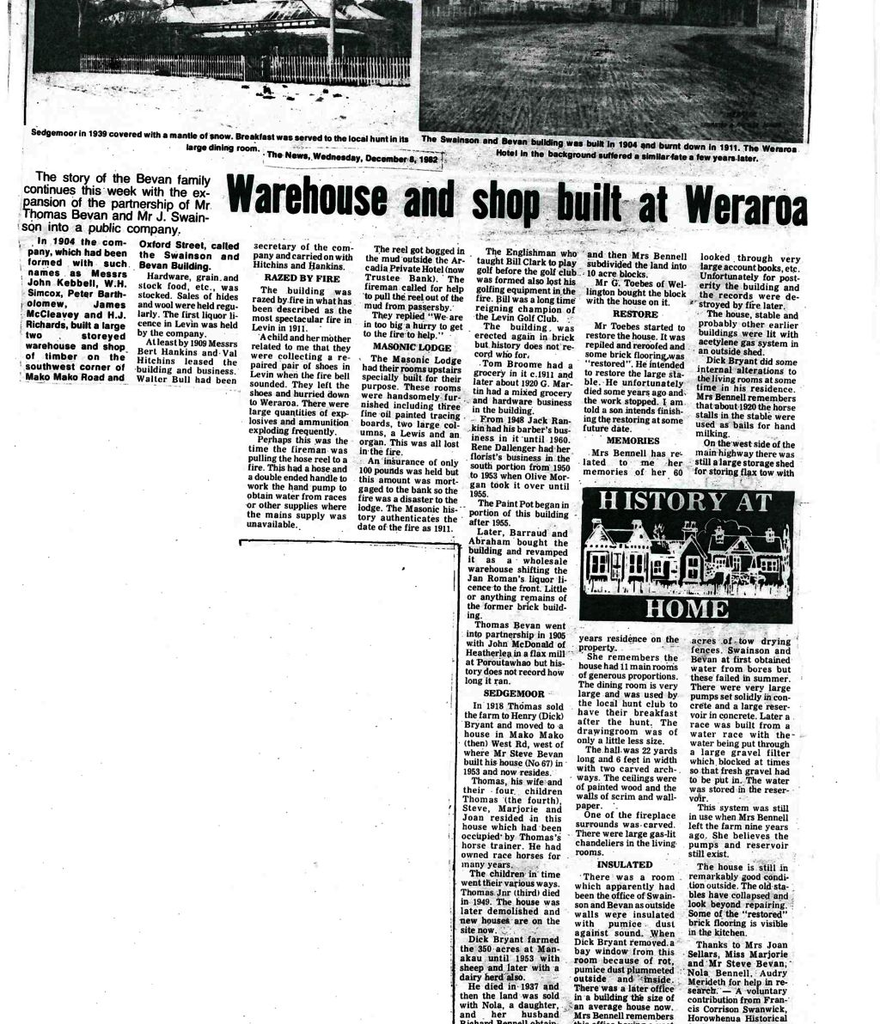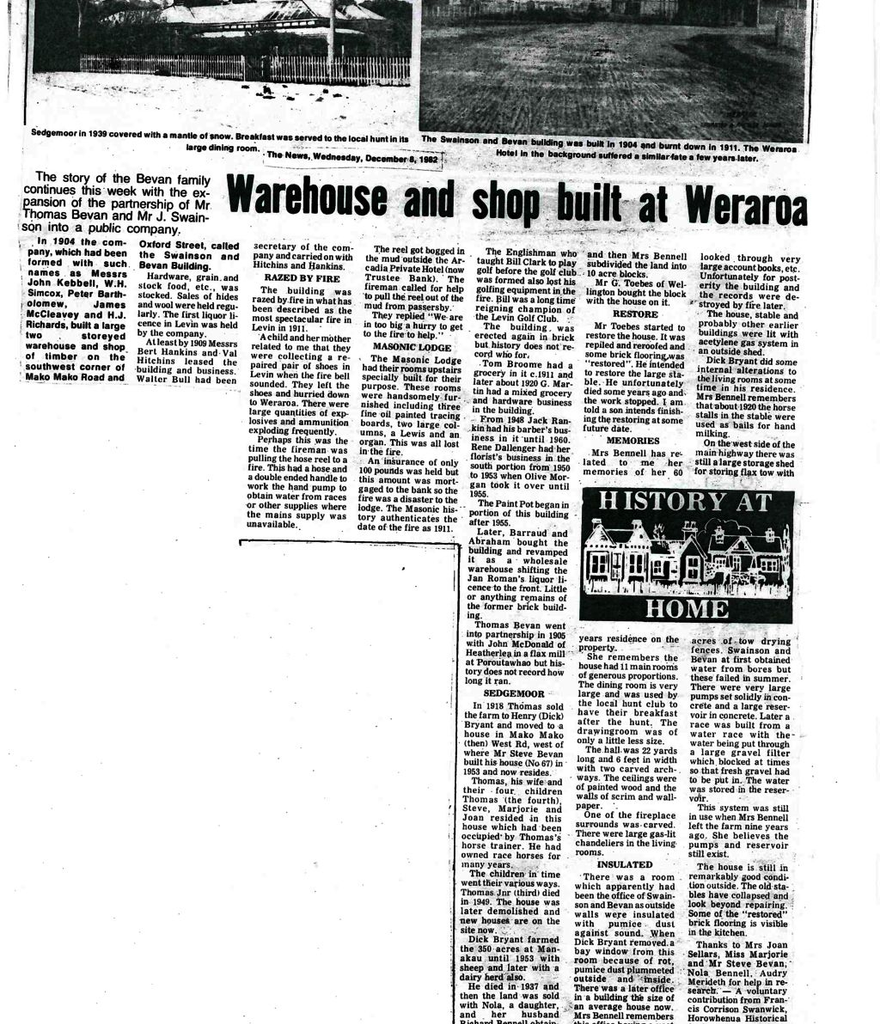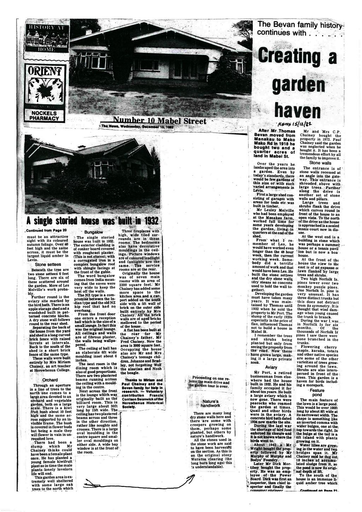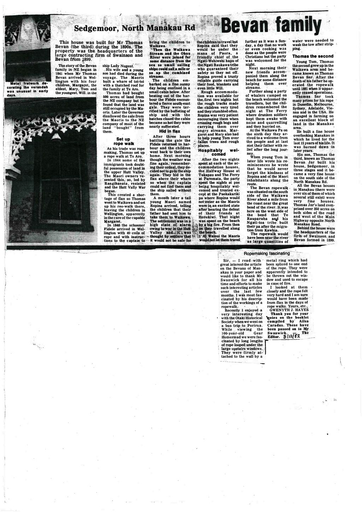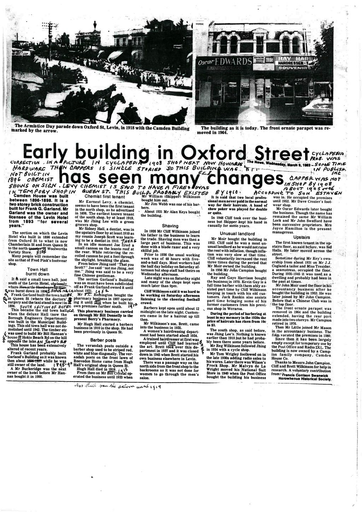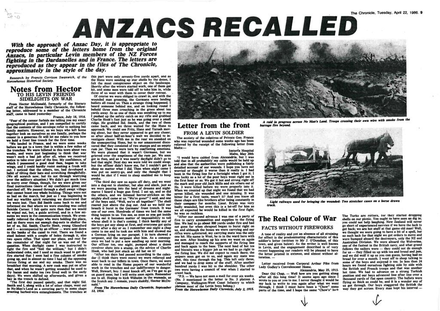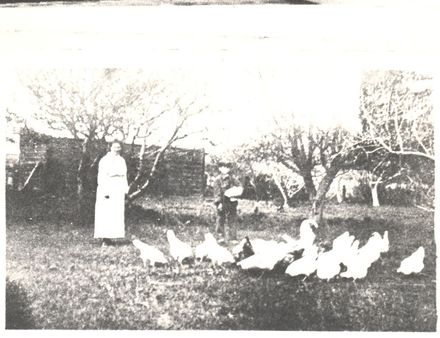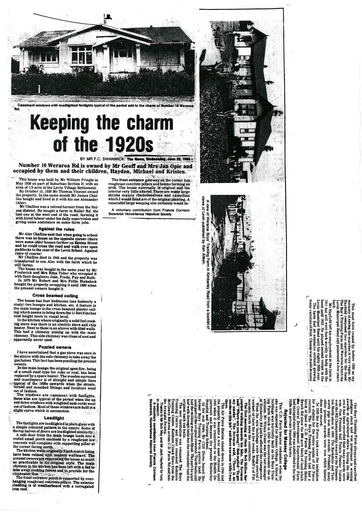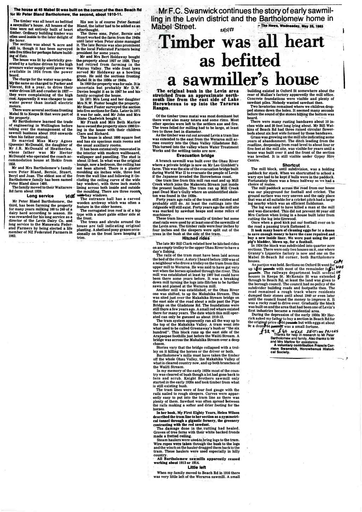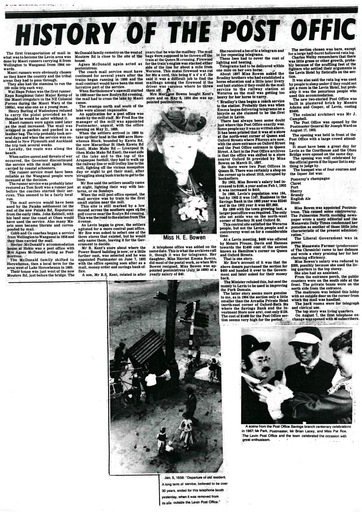Warehouse and shop built at Weraroa
- Description
 In 1904 the company, which had been formed with such names as Messrs John Kibbled, W. H. Simcox, Peter Bartholomew, James McCleavy and H. J. Richards, built a large two-storeyed warehouse and shop of timber on the southwest corner of Mako Mako Road and Oxford Street, called the Swainson and Bevan building.
In 1904 the company, which had been formed with such names as Messrs John Kibbled, W. H. Simcox, Peter Bartholomew, James McCleavy and H. J. Richards, built a large two-storeyed warehouse and shop of timber on the southwest corner of Mako Mako Road and Oxford Street, called the Swainson and Bevan building. Hardware, grain and stock food, etc., was stocked. Sales of hides and wool were held regularly. The first liquor licence in Levin was held by the company.
At least by 1909 Messrs Bert Hankins and Val Hitchins leased the building and business. Walter Bull had been secretary of the company and carried on with Hitchins and Hankins.
RAZED BY FIRE
The building was razed by fire in what has been described as the most spectacular fire in Levin in 1911.
A child and her mother related to me that they were collecting a repaired pair of shoes in Levin when the fire bell sounded. They left the shoes and hurried down to Weraroa. There were large quantities of explosives and ammunition exploding frequently.
Perhaps this was the time the fireman was pulling the hose reel to a fire. This had a hose and a double ended handle to work the hand pump to obtain water from races or other supplies where the mains supply was unavailable.
The reel got bogged in the mud outside the Arcadia Private Hotel (now Trustee Bank). The fireman called for help to pull the reel out of the mud from passersby. They replied “We are in too big of a hurry to get to the fire to help.”
MASONIC LODGE
The Masonic Lodge had their rooms upstairs specially built for their purpose.
These rooms were handsomely furnished including three fine oil painted tracing boards, two large columns, a Lewis and an organ. All this was lost in the fire.
An insurance of only 100 ponds was held but this amount was mortgaged to the bank so the fire was a disaster to the Lodge. The Masonic history authenticates the date of the fire as 1911.
The Englishman who taught Bill Clark to play golf before the golf club was formed also lost his golfing equipment in the fire. Bill was a long time reigning champion of the Levin Golf Club.
The building was erected again in brick, but history does not record who for.
Tom Broome had a grocery in it in c.1911 and later about 1920 G. Martin had a mixed grocery and hardware business in the building.
From 1948 Jack Rankin had his barber’s business in it until 1960. Rene Dallenger had her florist’s business in the south portion from 1950 to 1953 until Olive Morgan took it over until 1955.
The Paint Pot began in portion of this building after 1955.
Later, Barraud and Abraham bought the building and revamped it as a wholesale warehouse shifting the Jan Roman’s liquor licence to the front. Little or anything remains of the former brick building.
Thomas Bevan went into partnership in 1905 with John Macdonald of Heatherlea in a flax mill at Poroutawhao, but history does not record how long it ran.
SEDGEMOOR
 In 1918 Thomas sold the farm to Henry (Dick) Bryant and moved to a house in Mako Mako (then) West Rd, west of where Mr Steve Bevan built his house (No 67) in 1953 and now resides.
In 1918 Thomas sold the farm to Henry (Dick) Bryant and moved to a house in Mako Mako (then) West Rd, west of where Mr Steve Bevan built his house (No 67) in 1953 and now resides. Thomas, his wife and their four children Thomas (the fourth), Steve, Marjorie and Joan resided in this house which had been occupied by Thomas’s horse trainer. He had owned race horses for many years.
The children in time went their various ways. Thomas Jnr (third) died in 1949. The house was later demolished and new houses are on the site now.
Dick Bryant farmed the 350 acres at Manakau until 1953 with sheep and later with a dairy herd also.
He died in 1937 and when the land was sold with Nola, a daughter, and her husband Richard Bennell obtaining 59 acres and farming it. Richard died in 1973 and then Mrs Bennell subdivided the land into 10-acre blocks.
Mr G. Toebes of Wellington bought the block with the house on it.
RESTORE
Mr Toebes started to restore the house. It was repiled and reroofed and some brick flooring was “restored”. He intended to restore the large stable. He unfortunately died some years ago and the work stopped. I am told a son intends to finish the restoring at some future date.
MEMORIES
Mrs Bennell has related to me her memories of her 60 years residence on the property.
She remembers the house had 11 main rooms of generous proportions. The dining room was very large and was used by the local hunt club to have their breakfast after the hunt. The drawingroom was only a little less in size.
The hall was 22 yards long and 6 feet in width with two carved archways. The ceilings were of painted wood and the walls in scrim and wallpaper.
One of the fireplace surrounds was carved. There were large gas-lit chandeliers in the living rooms.
INSULATED
There was a room which apparently had been the office of Swainson and Bevan, as outside walls were insulated with pumice dust against sound. When Dick Bryant removed a bay window from this room because of rot, pumice dust plummeted outside and inside. There was a later office in a building the size of an average house now. Mrs Bennell remembers the office having a vast amount of the firm’s records and as a child looked through very large account books, etc. Unfortunately for posterity the building and the records were destroyed by fire later.
The house, stable and probably other early buildings were lit with acetylene gas system in an outside shed.
Dick Bryant did some internal alterations to the living room at some time in his residence. Mrs Bennell remembers that about 1920 the horse stalls in the stable were used as bails for hand milking.
On the west side of the main highway, there was still a large storage shed for storing flax tow with acres of tow-drying fences. Swainson and Bevan at first obtained water from bores but these failed in summer. These were very large pumps set solidly in concrete and a large reservoir in concrete. Later, a race was built from a water-race with the water being put through a large gravel filter which blocked at times so that fresh gravel had to be put in. The water was stored in the reservoir.
This system was still in use when Mrs Bennell left the farm nine years ago. She believes the pumps and reservoir still exist.
The house is still in remarkably good condition outside. The old stables have collapsed and look beyond repairing. Some of the “restored” brick flooring is visible in the kitchen.
Thanks to Mrs Joan Sellars, Miss Marjorie and Mr Steve Bevan, Nola Bennell, Audry Meredith for help in research.
Identification
- Date
- December 8, 1982
Taxonomy
- Community Tags

